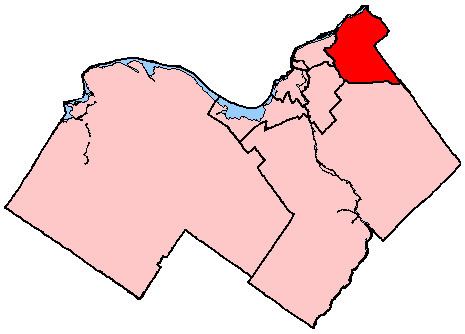Legislature House of Commons District created 1987 Last contested 2015 Province Ontario Elector 94,830 | MP Andrew Leslie
Liberal First contested 1988 District webpage profile, map Census division Ottawa | |
 | ||
Orléans (formerly Ottawa—Orléans, Gloucester—Carleton and Carleton—Gloucester) is a federal electoral district in Ottawa, Ontario, Canada, that has been represented in the House of Commons of Canada since 1988.
Contents
The riding was created as "Carleton—Gloucester" in 1987. Its name was changed to "Gloucester—Carleton" in 1996, but then changed back to "Carleton–Gloucester" in 1997. It was changed again in 2000 to "Ottawa—Orléans" and to just "Orléans" in 2013.
Despite having an English-speaking majority, Orléans is among the most francophone of the Ontario federal ridings, and a major centre of the Franco-Ontarian community. According to the 2001 Statistics Canada report, 35% of the riding population speaks French as their mother tongue. In recent years, the riding has experienced a major growth of population and increased housing projects.
In the 2004 federal election, the Liberal candidate Marc Godbout won over the Conservative candidate Walter Robinson by over 4% of the votes. Robinson, a former president of the Canadian Taxpayers Federation, was considered a favourite but failed to win support among Francophones. Ottawa—Orléans was also the riding where the NDP had Canada's youngest woman candidate, Crystal LeBlanc, who received 5905 votes in the 2004 federal election.
Geography
It encompasses the suburban community of Orleans in the east end of Ottawa, Ontario (northern and eastern parts of the former city of Gloucester, Ontario plus the northwestern corner of the former city of Cumberland) as well as the neighbourhood of Blackburn Hamlet and the communities of Notre-Dame-des-Champs and Carlsbad Springs.
The riding consists of the part of the City of Ottawa bounded on the north by the Ottawa River, and on the west, south and east by a line drawn due south from the river to the mouth of Green's Creek, south along that creek, southwest along Regional Road 174 to Blair Road, south to Innes Road, west to a transmission line, south to an abandoned Canadian Pacific Railway track, west to Highway 417, southeast to Ramsayville Road, south to Mitch Owens Road, east to Boundary Road, south to Devine Road, east to Frontier Road, north to Carlsbad Lane and its northern production to Tenth Line Road, north to Wall Road, east to Frank Kenny Road, north to Frank Kenny Road, north to the Ottawa River.
Demographics
According to the Canada 2011 Census; 2013 representationEthnic groups: 77.6% White, 6.5% Black, 3.7% South Asian, 3.1% Arab, 2.4% Aboriginal, 2.1% Chinese, 1.1% Filipino, 1.0% Latin American
Languages: 55.9% English, 33.1% French, 2.3% Arabic, 1.5% Chinese
Religions: 75.8% Christian (52.4% Catholic, 5.5% United Church, 5.4% Anglican, 1.5% Pentecostal, 1.4% Baptist, 1.3% Christian Orthodox, 1.1% Presbyterian, 7.2% Other), 4.8% Muslim, 1.2% Hindu, 16.8% No religion
Median income (2010): $46,606
Average income (2010): $52,230
History
The federal riding was created as "Carleton—Gloucester" in 1987 from parts of Nepean—Carleton and Ottawa—Carleton ridings. It consisted initially of
In 1996, it was renamed "Gloucester—Carleton", and defined to consist of
The name of the electoral district was changed in 1997 back to "Carleton—Gloucester", and in 2000 to "Ottawa—Orléans".
Following the 2012 redistribution of Canada's ridings, the riding will lose the neighbourhood of Beacon Hill South from Ottawa—Vanier, and will gain the Cardinal Creek area from Glengarry—Prescott—Russell and the rural area surrounding Carlsbad Spring from parts of Glengarry—Prescott—Russell and Nepean—Carleton.
Ottawa–Orléans
Note: Conservative vote is compared to the total of the Canadian Alliance vote and Progressive Conservative vote in 2000 election.
Note: Canadian Alliance vote is compared to the Reform vote in 1997 election.
